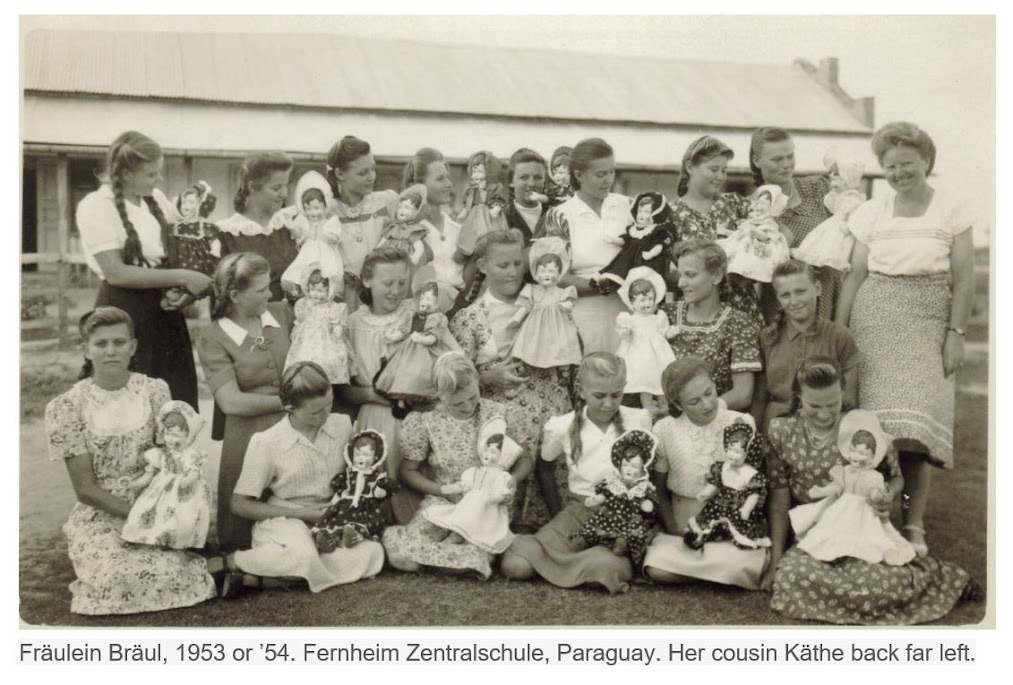Fräulein Bräul left an indelible mark on two generations of high school students in the Mennonite Colony of Fernheim, Paraguay. Former students and acquaintances recall that Marga Bräul demanded the highest effort and achievements of her students, colleagues and of herself—the kind of teacher you either love or hate but will never forget!
In March 1947, Marga was offered a position at the Fernheim Secondary School (Zentralschule). A recent refugee to Paraguay from war-torn Europe,
she taught mathematics, physics, and chemistry. In 1952, she was the only female
faculty member (note 1).
Marga wedded a strong commitment to academics with a passion
for quality arts and crafts. She provided extensive extra-curricular
instruction to students in handiwork and was especially renowned for her
artwork—which included painting and woodworking— end of year art exhibits with
students, theatre sets, and festival decorations.
Marga’s pedagogical philosophy was holistic; she told Mennonite educators in Canada in 1972:
"It is not a matter of how much time you have, but how you
utilize it. When you are tired of working with your brain, then take a drawing
or craft to hand and rest your mind. After a while your brain is rested and
your hand has produced something to give you satisfaction. Now you can turn to
your studies refreshed and satisfied." (Note 2)
She was known to have a tireless, creative capacity with a
broad range of interests and gifts. Marga was more theologically literate than
most pastors; on a visit to Canada she gave me an informed albeit decidedly conservative
and vigorous evaluation of the work of German existentialist theologian Rudolf
Bultmann--I was doing my PhD at the time on this material! She loved debate
and, despite concerns of some parents and churches, she became a strong
advocate for sports training for girls in Mennonite schools as well.
Not only was Marga Bräul able to engage and inspire—she
could terrify, according to former students.
In the early 1970s she was asked by North Americans whether Mennonite youth in Paraguay shared the rebelliousness of adolescents in other parts of the world. Bräul answered:
Our youth have a full day. They must in addition to their
studies, keep the yard and buildings of the school clean and in good repair.
Our girls plant flowers and generally tend the garden. Twice a week the girls
clean the dining room thoroughly, and they are also in charge of meals. There
is little time for mischief. (Note 3)
Marga’s motto was to “do your duty,” which reflected both
the strengths and weaknesses of her generation’s worldview and the value it
placed on obedience. In 1972, the western cultural revolution had not yet
shaken the Paraguayan Chaco.
Marga witnessed the impact of Stalin’s terror firsthand. In
1933 at age 14, her 74-year-old Klassen grandfather was arrested and imprisoned
in Halbstadt without food for two weeks. He was released but died on the way
back. That same day, their Paulsheim home was ransacked and the pillow and
mattress on which his bed-ridden wife lay were taken and cut-open. She went
into shock and unable to speak when Marga’s parents found her and died that
very night. Because they were deemed kulaks, wagons came on the day of the
burial and all the furniture, beds and clothes were carried off. One of Marga’s
disenfranchised uncles and minister Aron Bräul hid at their home for a time.
Four of her uncles were arrested and shot or exiled (1937-38). Her father
survived because he had had tuberculosis and was left with only a part of one
lung. Her younger brother however was deported—in his father's stead, they
believed (note 4).
Despite the turbulence of the 1930s Marga completed high school and also entered teachers’ college at the Soviet German Language-Pedagogical Institute, with one year of training in Odessa and one year in the port city of Berdjansk on the Sea of Azov.
Marga majored in politically safe or neutral courses:
mathematics, algebra, geometry, physics and chemistry. She was not however exempt
from military studies, and was trained as a parachutist (note 5). After
teachers’ college, she taught two years in a Russian school near Melitopol on
the Molotschna River.
With German occupation in 1941, Marga was employed as a bookkeeper and translator for the occupation forces and stationed in Nishnije Serogosy (Nyzhni Sirohozy), Zaporoshje (note 6). With the retreat of the Germans in 1943, she also ended up in Warthegau/Poland. In 1944 in Lutbrandau, she was retrained for teaching in the German Reich under S.S. Storm Leader and friend of the Mennonites, Karl Götz.
Marga inspired and shaped hundreds of Mennonite high school students over more than four decades at the Fernheim high school—including her much younger cousin Käthe Bräul, my mother.
---Notes---
Note 1: Cf. Joseph Winfield Fretz, Pilgrims in Paraguay: The
Story of Mennonite Colonization in South America (Scottdale, PA: Herald, 1953),
80, https://catalog.hathitrust.org/Record/001448782.
Note 2: Marga Bräul, cited in Lore Lubosch, “Little time
left for mischief,” Mennonite Mirror 2, no. 1 (September 1972), 11–12; 11, https://cmbs.mennonitebrethren.ca/publications/mennonite-mirror/.
Note 3: Cited in Lubosch, “Little time left for mischief,”
12.
Note 4: Agatha Klassen Bräul, Diary [Marga’s mother]. Copy
in my possession.
Note 5: Gati Harder, “Bräul, Marga,” Lexikon der Mennoniten
in Paraguay, Online 2011, http://www.menonitica.org/lexikon/?B:Br%E4ul%2C_Marga.
Note 6: Einwandererzentrale (Central Immigration Office),
National Archives Collection Microfilm Publication, EWZ A3342-EWZ50-A073, 2054.






Comments
Post a Comment